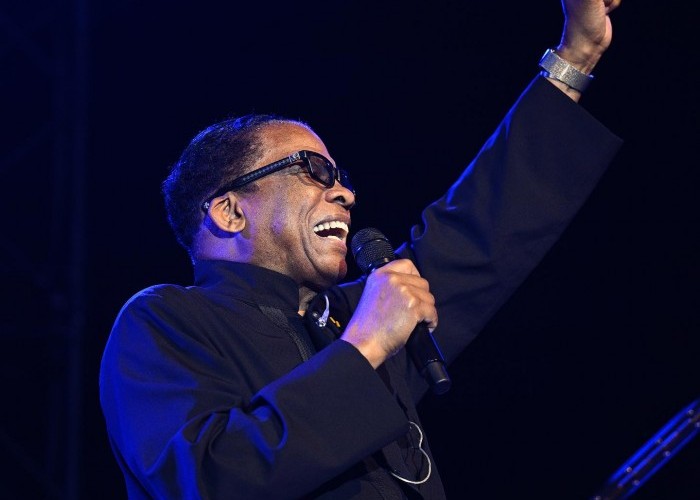Oct 28, 2025 10:47 AM
In Memoriam: Jack DeJohnette, 1942–2025
Jack DeJohnette, a bold and resourceful drummer and NEA Jazz Master who forged a unique vocabulary on the kit over his…

Herbie Hancock’s closing-night performance reflected the buoyant mood of this year’s Ottawa Jazz Festival.
(Photo: Dan Nawrocki)Canada’s capital city was beset by oppressive humidity and smoke from distant forest fires, broken occasionally by thunderstorms, but the 43rd edition of the Ottawa Jazz Festival, held June 23–30, took it all in stride.
Herbie Hancock reflected the buoyant mood of those who braved the unusual combination of elements when he wrapped up the eight-day event, leading a musically deep quintet featuring trumpeter Terence Blanchard, guitarist Lionel Loueke, bassist James Genus and young drummer Jaylen Petinaud. Despite a sound mix that pushed Genus and Petinaud into uncomfortably bombastic territory — frequently drowning out Blanchard and Loueke’s lithe contributions — the largest crowd of the festival’s run hung on every note. Following an opening medley that touched on several of Hancock’s best-known compositions, the band played sprightly tribute to his long-time friend, Wayne Shorter, on Blanchard’s fusion-tinged arrangement of the late saxophonist’s “Footprints.” Moving through selections from Hancock’s latter-day catalog, the band went on to ramble across “Actual Proof,” “Come Running To Me,” “Secret Sauce” and “Chameleon,” never losing sight of their mission to play to the audience’s furthest reaches, nuance be damned.
For a younger generation, Vijay Iyer — a frequent visitor to the Ottawa festival since his first appearance in 2007 — might well seem like the obvious successor to Hancock, given the number of formats he has worked in and his comfort with both acoustic and electric keyboards. Away from the elements, inside Canada’s National Arts Centre, Iyer appeared as part of the collective Love In Exile trio with singer Arooj Aftab and electric bassist Shahzad Ismaily, featuring music from their recent eponymous recording. Solemn and densely layered, their music seemed particularly well suited to the small, steeply layered room, before a large crowd so in tune with the trio that Aftab noted what good listeners they were. In return, the trio relaxed into its music, creating that rare atmosphere where the space between musician and listener seems to disappear.
In the same room, the duo of Loueke and vocalist Gretchen Parlato also worked the softer side of the sonic spectrum, creating an intimate rapport as they focused on songs from Lean In, their expressive new recording. Infused with a variety of African rhythms, the music was an exceptionally fine showcase for both artists and their relaxed approach to the material, and without the album’s additional musicians or vocal overdubbing, the pair reached even deeper into the songs. As always, Parlato’s voice was breathy and conversational, Loueke’s guitar playing lithe and percussive. Adding to the low-key atmosphere was the appearance of Parlato’s young son, who added vocals and some insouciant attitude to the charming set’s conclusion.
Leading a trio that included frequent drum companion Bill Stewart and double-bassist Vicente Archer, guitarist John Scofield reached back to the bebop era for a smoking take of “Budo,” drifted into the ‘60s for a snaky version of Bob Dylan’s “Mr. Tambourine Man” and applied his distinctive harmonic signature to a handful of other compositions. Sco is never less than engaged and tuneful, and his connection with Stewart seems preternatural, but Archer’s contributions sounded somewhat one-dimensional by contrast.
More than a decade after the release of her best-selling album, The Reminder and Metals, Canadian singer Feist demonstrated her remarkable command of stagecraft, stepping effortlessly between a tightly programmed set and playful interaction with her outdoor audience. Shadowed by a videographer, whose work was projected on a large screen, she ventured down the center aisle to acknowledge she was performing on “unceded” Indigenous land — in sight of Canada’s Parliament buildings — and later engaged a starstruck young fan in an impromptu duet. Onstage, she was all business, leading an admirably tight band through a 90-minute set that spanned her two-decade solo career. While some popular musicians feel the need to pander to the audience when they perform at a jazz festival, Feist made no such concessions. In fact, she channeled her inner Patti Smith to attack “Sealion,” which incorporates part of Nina Simone’s “See-Line Woman,” with punk rock ferocity.
Torrential rain is never welcome at outdoor shows; even less so when the performer onstage has a low-key approach like vocalist Melody Gardot. The skies opened as she ended her third number, forcing her to combat the sound of rain beating on umbrellas and other surfaces. Before the rains came, she duetted with pianist/vocalist Philippe Powell on several Brazilian-tinged pieces, achieving a peaceful, intimate dialogue that could not compete against the storm. DB

Jack DeJohnette boasted a musical resume that was as long as it was fearsome.
Oct 28, 2025 10:47 AM
Jack DeJohnette, a bold and resourceful drummer and NEA Jazz Master who forged a unique vocabulary on the kit over his…

Goodwin was one of the most acclaimed, successful and influential jazz musicians of his generation.
Dec 9, 2025 12:28 PM
Gordon Goodwin, an award-winning saxophonist, pianist, bandleader, composer and arranger, died Dec. 8 in Los Angeles.…

Flea has returned to his first instrument — the trumpet — and assembled a dream band of jazz musicians to record a new album.
Dec 2, 2025 2:01 AM
After a nearly five-decade career as one of his generation’s defining rock bassists, Flea has returned to his first…

To see the complete list of nominations for the 2026 Grammy Awards, go to grammy.com.
Nov 11, 2025 12:35 PM
The nominations for the 2026 Grammy Awards are in, with plenty to smile about for the worlds of jazz, blues and beyond.…

Nov 13, 2025 10:00 AM
For results of DownBeat’s 90th Annual Readers Poll, complete with feature articles from our December 2025 issue,…







